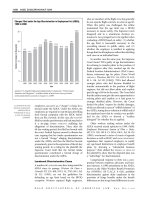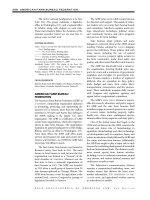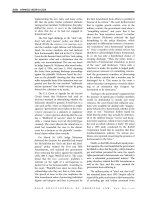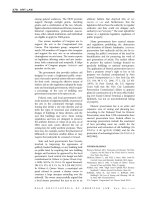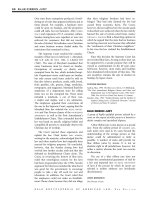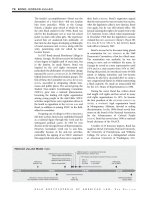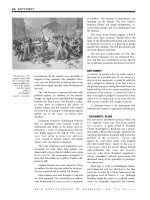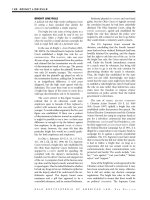Gale Encyclopedia Of American Law 3Rd Edition Volume 12 P37 pptx
Bạn đang xem bản rút gọn của tài liệu. Xem và tải ngay bản đầy đủ của tài liệu tại đây (145.61 KB, 10 trang )
jurisdiction, so may they on similar facts.
Newspaper corporations are no more entitled
to the favored position which the Times and its
friends would accord them than they are
entitled to many other preferences for which
they have unsuccessfully argued. In Mabee v.
White Plains Publishing Co., 327 U.S. 178, 184,
this Court held: “As the press has business
aspects, it has no special immunity from laws
applicable to business in general.” This case
concerned the applicability of the Fair Labor
Standards Act to newspapers. This Court has
likewise held newspaper corporations subject to
the National Labor Relations Act, As s ociated Press
v. N. L. R. B., 301 U.S. 103 and to the anti-trust
laws, Lorain Journal Compan y v. United States,
342 U.S. 143.
Hanson v. Denckla, 357 U.S. 235, relied
upon by the Times as contrary to the decisions
below, is easily distinguishable. As this Court
pointed out, there was no solicitation of
business i n Florida by the foreign corporation,
either in person or by mail. In the case at bar
the Times solicited business in both manners.
The cause of action in Hanson v. Denckla did
not arise out of an act done or transaction
consummated in the forum. On the contrary,
this cause of action arose out of the very
distribution of the newspapers by the Times in
Alabama. Surely the Times cannot contend that
its introduction of these newspapers in Alabama
was involuntary.
73
The foreign corporation in
Hanson v. Denckla had received no benefit from
the laws of the forum. The manifold business
activities of the Times—news gathering, solici-
tation of advertising and distribution—have
received the protection of Alabama laws.
Finally (Brief, pp. 86–88) the Times suggests
that even though it might be amenable to suit in
Alabama under due process standards, the
commerce clause nevertheless bars the Alabama
action. The most recent decision of this Court
cited in support of this proposition was handed
down in 1932. It seems scarcely necessary to
observe that this Court, which has develop ed
enlightened standards givi ng expanded scope to
jurisdiction over foreign corporations in such
cases as International Shoe, McGee, Travelers
Health and Scripto will not grant review to turn
the clock back to 1932, and invoke the rigid
concepts of earlier days under the aegis of the
commerce clause. And the Times must concede
that this Court has not “hitherto” held that tort
actions against foreign corporations—fairly
subject to in personam jurisdiction—are uncon-
stitutional as undue burdens on interstate
commerce (Brief, p. 87).
Accordingly, even without a general appear-
ance, the Times would have presented no
unsettled federal question of jurisdiction for
review by this Court on certiorari.
CONCLUSION
For the foregoing reason s it is respectfully
submitted that the writ of certiorari should be
dismissed as improvidently granted; in the alter-
native, respondent respectfully submits that this
case should be affirmed.
Respectfully submitted,
ROBERT E. STEINER III,
SAM RICE BAKER,
M. ROLAND NACHMAN JR.,
Attorneys for Respondent.
STEINER, CRUM & BAKER,
CALVIN WHITESELL,
Of Counsel.
CERTIFICATE
I, M. Roland Nachman, Jr., of Counsel for
Respondent, and a member of the bar of this
Court, hereby certify that I have mailed copies
of the foregoing Brief and of respondent’s Brief
in No. 40, Abernathy v. Sullivan, air mail,
postage prepaid, to Messrs. Lord, Day & Lord,
Counsel for pet itioner, at their offices at 25
Broadway, New York, New York. I also certify
that I have mailed a copy of the foregoing Brief,
air mail, postage prepaid, to Edward S. Green-
baum, Esquire, 285 Madison Avenue, New
York, New York, as attorney for American
Civil Liberties Union and the New York Civil
Liberties Union, as amici curiae; to Messrs.
Kirkland, Ellis, Hodson, Chaffetz & Masters,
attorneys for The Tribune Company, as amicus
curiae, at their offices at 130 East Randolph
Drive, Chicago 1, Illinois; and to William P.
Rogers, Esquire, attorney for The Washington
Post Company, as amicus curiae, at his office at
200 Park Avenue, New York 17, New York.
This day of October, 1963.
M. Roland Nachman Jr.,
Of Counsel for Respondent.
73
But compare Times Brief, p. 81.
MILESTONES IN THE LAW NEW YORK TIMES V. SULLIVAN 347
U.S. SUPREME
COURT,
OCTOBER 1963
BRIEF FOR
RESPONDENT
GALE ENCYCLOPEDIA OF AMERICAN LAW, 3RD E DITION
APPENDIX A
Title 7, Section 909 of the Code of Alabama:
“TRUTH OF THE WORDS, ETC., EVI-
DENCE UNDER THE GENERAL ISSUE.—
In all actions of slander or libel, the truth of
the words spoken or written, or the circum-
stances under which they were spoken or
written, may be given in evidence under the
general issue in mitigation of the damages.”
Truth specially pleaded is an absolute bar to
a civil libel action, Webb v. Gray, 181 Ala. 408,
62 So. 194; Ripps v. Herrington, 241 Ala. 209,
212, 1 So. 2d 899; Johnson Publishing Co. v.
Davis, 271 Ala. 474, 124 So. 2d 441.
Title 7, Section 910 of the Code of Alabama:
“LIBEL OR SLANDER; DEFAMATORY
MATTER.—In an action for libel or slander,
it shall be sufficient to state, generally, that
the defamatory matter was published or
spoken of the plaintiff; and if the allegation
be denied, the plaintiff must prove, on the
trial, the facts showing that the defamatory
matter was published or spoken of him.”
Title 7, Section 913 of the Code of Alabama:
“RETRACTION MITIGATES DAMAGES.—
The defendant in an action of slander or libel
may prove under the general issue in
mitigation of damages that the charge was
made by mistake or through inadvertence,
and that he has retracted the charge and
offered amends before suit by publishing an
apology in a newspaper when the charge had
been thus promulgated, in a prominent
position; or verbally, in the presence of
witnesses, when the accusation was verbal
or written, and had offered to certify the
same in writing.”
Title 7, Section 914 of the Code of Alabama:
“AGGRIEVED PERSON MUST GIVE NO-
TICE TO PUBLISHERS OF ALLEGED
LIBEL BEFORE VINDICTIVE DAMAGES
CAN BE RECOVERED.—Vindictive or pu-
nitive damages shall not be recovered in any
action for libel on account of any publication
concerning the official conduct or actions of
any public officer, or for the publication of
any matter which is proper for public
information, unless five days before the
bringing of the suit the plaintiff shall have
made written demand upon the defendant
for a public retraction of the charge or matter
published; and the defendant shall have
failed or refused to publish within five days
in as prominent and public a place or
manner as the charge or matter published
occupied, a full and fair retraction of such
charge or matter.”
Title 7, Section 915 of the Code of Alabama:
“WHEN ACTUAL DAMAGES ONLY
RECOVERABLE.—If it shall appear on the
trial of an action for libel that an article
complained of was published in good faith,
that its falsity was due to mistake and
misapprehension, and that a full correction
or retraction of any false statement therein
was published in the next regular issue of
said newspaper, or in case of daily news-
papers, within five days after service of said
notice aforesaid, in as conspicuous a place
and type in said newspaper as was the article
complained of, then the plaintiff in such case
shall recover only actual damages.”
Title 7, Section 916 of the Code of Alabama:
“RECANTATION AND TENDER; EFFECT
OF.—If the Defendant, after or before suit
brought, make the recantation and amends
recited in the preceding sections, and also
tender to the plaintiff a compensation in
money, and bring the same into court, the
plaintiff can recover no costs, if the jury
believe and find the tender was sufficient.”
Title 7, Section 917 of the Code of Alabama:
“EFFECT OF TENDER RECEIVED.—The
receipt of the money tendered, if before suit
brought, is a bar to the action; if after suit,
releases the defendant from all damages and
costs, except the costs which accrued before
the tender and receipt of the money.”
348 NEW YORK TIMES V. SULLIVAN MILESTONES IN THE LAW
U.S. SUPREME
COURT,
OCTOBER 1963
BRIEF FOR
RESPONDENT
GALE ENCYCLOPEDIA OF AMERICAN LAW, 3RD E DITION
In the S upreme Court of
the United States
October Term, 1963
No. 40
RALPH D. ABERNATHY,
FRED L. SHUTTLESWORTH,
S. S. SEAY, SR., AND
J. F. LOWERY, PETITIONERS,
V.
L. B. SULLIVAN, RESPONDENT
ON WRIT OF CERTIORARI TO THE
SUPREME COURT OF ALABAMA
BRIEF FOR THE PETITIONERS
HARRY H. WACHTEL,
SAMUEL R. PIERCE JR.,
JOSEPH B. RUSSELL,
DAVID N. BRAININ,
STEPHEN J. JELIN,
CLARENCE B. JONES,
DAVID G. LUBELL ,
CHARLES B. MARKHA M,
WACHTEL & MICHAELSON,
BATTLE, FOWLER, STOKES & KHEEL,
LUBELL, LUBELL & JONES,
Of Counsel.
Of Counsel.
I. H. WACHTEL,
CHARLES S. CONLEY,
BENJAMIN SPIEGEL,
RAYMOND S. HARRIS,
Attorne ys for Petiti oner s.
1100 - 17th St., N.W.
Washington, D.C. 20036
k
INDEX
Opinions Below
Jurisdiction
Questions Presented
Constitutional and Statutory Provisions Involved
Statement
1. The Nature of the Publication
2. The Evidence Concerning Publication
3. The Alleged Libel
4. Biased Trial and Judgment
Summary of Argument
Argument
I. This court must nullify schemes which encroach
on freedom of utterance under the guise of
punishing libel
II. The proceedings below constitute prohibited
state action and, together with the concepts of
libel enunciated by the Alabama courts, uncon-
stitutionally abridge freedoms of press, speech,
assembly and association
A. Prohibited state action is clearly involved
B. The First and Fourteenth Amendments
protect criticism and discussion of the
political conduct and actions of public
officials
C. Vagueness and indefiniteness of standards
require reversal of the judgment below
D. Respondent’s erroneous contentions as to
the defense of truth
III. The judgment and proceedings below violate
petitioners’ First and Fourteenth Amendment
rights in that the record is devoid of evidence of
authorization or publication of the ad in suit, and
they require of total strangers to the publication
expression of disbelief and disavowal
A. Lack of evidence as denial of due process of
law
B. Prejudicial rulings below concerning “ratifi-
cation”; silence as consent
C. Compulsory disclosure of belief
IV. Petitioners’ rights to Due Process and Equal
Protection of Law and to a fair and impartial trial
as guaranteed by the Fourteenth Amendment
were flagrantly violated and abridged by the
proceedings below
Jurisdiction to redress flagrant violations of
fundamental constitutional rights “is not to
be defeated under the name of local practice”
Conclusion
Appendix A
Appendix B
k
Petitioners Abernathy, Shuttlesworth, Seay,
and Lowery submit this brief for reversal of the
judgment of the Supreme Court of Alabama
entered on August 30, 1962, which affirmed a
$500,000 libel judgment for punitive damages
entered on November 3, 1960 in the Circuit
Court of Montgomery County, Alabama against
petitioners and The New York Times Company,
their co-defendant, in a suit for alleged libel,
based on an advertisement (R. 6, 1925;
reproduced in Appendix A infra, p. 63) printed
in The New York Times on March 29, 1960,
appealing for contributions to aid the civil rights
movement in the South.
MILESTONES IN THE LAW NEW YORK TIMES V. SULLIVAN 349
U.S. SUPREME
COURT,
OCTOBER 1963
BRIEF FOR THE
PETITIONERS
GALE ENCYCLOPEDIA OF AMERICAN LAW, 3RD E DITION
OPINIONS BELOW
The Trial Court (Circuit Court of Mon-
tgomery County) did not write an opinion. Its
judgment is printed at R. 862. The Opinion of
the Alabama Supreme Court (R. 1139) affirm-
ing said judgment is reported at 273 Ala. 656.
JURISDICTION
The judgment of the Supreme Court of
Alabama was entered on August 30, 1962 (R.
1180). The petition for writ of certiorari was filed
on November 21, 1962 and was granted on
January 7, 1963, 371 U.S. 946 (R. 1194). The
jurisdiction of this Court rests upon 28 U. S. C. §
1257(3).
1
QUESTIONS PRESENTED
2
1. May the State of Alabama, under the guise
of civil libel prosecutions, suppress criticism of
the political conduct of unnamed public
officials, consistently with the guaranteed free-
doms of speech, press, assembly and association
of the First and Fourteenth Amendments?
2. Were petitioners’ rights to due process of
law, as guaranteed by the Fourteenth Amend-
ment, violated by a $500,000 punitive judgment
against them upon a record devoid of evidence
of authorization, consent, publication or malice
on their part or of pecuniary damage to
respondent?
3. Does the rule of law adopted by the State
of Alabama below, requiring total strangers to
the challenged publication, to procure and
study it and, under pain of $500,000 punitive
damages, “retract” any claimed libel therein,
impose an arbitrary and onerous burden which
unconstitutionally infringes petitioners’ rights
under the First and Fourteenth Amendments?
4. Were the rights of Negro petitioners to
equal protection, due process of law and fair
and impartial trial under the Fourteenth
Amendment violated by the trial of the suit
brought against them by a white public official
of Montgomery (i) in a segregated Courtroom,
rife with racial bias and community hostility,
(ii) before an all-white jury (from which Negro
citizens were intentionally and systematically
excluded), and (iii) before a trial judge, not
properly qualified, who has stated from the
Bench that the Fourteenth Amendment is
inapplicable in Alabama Courts, which are
governed by “white man’s justice”?
3
CONSTITUTIONAL AND STATUTORY
PROVISIONS INVOLVED
The Constitutional provisions involved are
the First, Fourteenth and Fifteenth Amend-
ments to the United States Constitution which
are set forth in Appendix B, infra, pp. 65–66.
The Statutes involved are Title 7, Sections
913–16 of the Code of Alabama (i.e., the
Alabama “Retraction” Statute) and Title 14,
Sections 347 and 350 thereof (i.e., the Alabama
“Criminal Libel” Statute) which read as follows:
Title 7, Section 913 of the Code of Alabama:
“RETRACTION MITIGATES DAMAGES.—
The defendant in an action of slander or libel
may prove under the general issue in
mitigation of damages that the charge was
made by mistake or through inadvertence,
and that he has retracted the charge and
offered amends before suit by publishing an
apology in a newspaper when the charge had
been thus promulgated, in a prominent
position; or verbally, in the presence of
witnesses, when the accusation was verbal
or written, and had offered to certify the
same in writing.”
Title 7, Section 914 of the Code of Alabama:
“AGGRIEVED PERSON MUST GIVE NO-
TICE TO PUBLISHERS OF ALLEGED
LIBEL BEFORE VINDICTIVE DAMAGES
CAN BE RECOVERED.—Vindictive or pu-
nitive damages shall not be recovered in any
action for libel on account of any publication
concerning the official conduct or actions of
1
By letter of the Clerk of this Court dated August 9, 1963,
the time of petitioners to file this brief has been extended to
September 9, 1963.
2
Influenced by the landmark decisions of this Court in the
“sit in” cases (n. 6, infra), NAACP v. Button, 371 U.S. 415
and Johnson v. Virginia, 373 U.S. 61 among others, and the
historic events which have taken place since the filing of the
petition for writ of certiorari herein on November 21, 1962,
petitioners have in this brief consolidated the five questions
there presented to this Court so as to focus their argument
on the all-pervasive issue of the impingement on and serious
threat to their First and Fourteenth Amendment rights.
3
Judge Jones On Courtroom Segregation, 22 The Alabama
Lawyer, No. 2, pp. 190–192 (1961), which reprints
“Statement made from the Bench of the Circuit Court of
Montgomery County, February 1, 1961, ” during the
trial of the related libel action by Mayor Earl James of
Montgomery against The New York Times Company and
the four Negro petitioners herein. On March 17, 1961, Judge
Jones entered his order denying the new trial application
herein (R. 970).
350 NEW YORK TIMES V. SULLIVAN MILESTONES IN THE LAW
U.S. SUPREME
COURT,
OCTOBER 1963
BRIEF FOR THE
PETITIONERS
GALE ENCYCLOPEDIA OF AMERICAN LAW, 3RD E DITION
any public officer, or for the publication of
any matter which is proper for public
information, unless five days before the
bringing of the suit the plaintiff shall have
made written demand upon the defendant
for a public retraction of the charge or matter
published; and the defendant shall have
failed or refused to publish within five days
in as prominent and public a place or
manner as the charge or matter published
occupied, a full and fair retraction of such
charge or matter.”
Title 7, Section 915 of the Code of Alabama:
“WHEN ACTUAL DAMAGES ONLY
RECOVERABLE.—If it shall appear on the
trial of an action for libel that an article
complained of was published in good faith,
that its falsity was due to mistake and
misapprehension, and that a full correction
or retraction of any false statement therein
was published in the next regular issue of
said newspaper, or in case of daily news-
papers, within five days after service of said
notice aforesaid, in as conspicuous a place
and type in said newspaper as was the article
complained of, then the plaintiff in such case
shall recover only actual damages.”
Title 7, Section 916 of the Code of Alabama:
“RECANTATION AND TENDER; EFFECT
OF.—If the defendant, after or before suit
brought, make the recantation and amends
recited in the preceding sections, and also
tender to the plaintiff a compensation in
money, and bring the same into court, the
plaintiff can recover no costs, if the jury
believe and find the tender was sufficient.”
Title 14, Section 347 of the Code of
Alabama:
“LIBEL.—Any person who publishes a libel
of another which may tend to provoke a
breach of the peace, shall be punished, on
conviction, by fine and imprisonment in the
county jail, or hard labor for the county; the
fine not to exceed in any case five hundred
dollars, and the imprisonment or hard labor
not to exceed six months.”
Title 14, Section 350 of the Code of
Alabama:
“DEFAMATION.—Any person who writes,
prints, or speaks of and concerning any
woman, falsely imputing to her a want of
chastity; and any person who speaks, writes,
or prints of and concerning another any
accusation falsely and maliciously importing
the commission by such person of a felony,
or any other indictable offense involving
moral turpitude, shall, on conviction, be
punished by fine not exceeding five hundred
dollars, and imprisonment in the county jail,
or sentenced to hard labor for the county,
not exceeding six months; one or both, at the
discretion of the jury.
STATEMENT
Numerous recent decisions of this Court
4
have focused sharply on the intense nationwide
efforts to secure the constitutional rights of
Negroes, and on the numerous unconstitutional
acts committed in various Southern states to
frustrate these efforts. The four petitioners
herein are Negro ministers (resident in Alabama
at all relevant times) and religious and spiritual
leaders of the movement to secure civil rights in
Alabama and throughout the South.
1. The nature of the publication
To enlist public support and raise funds for
the legal defense of Dr. Martin Lut her King, Jr.
(who shortly before had been indicted in
Alabama for perjury)
5
, and in aid of the non-
violent demonstrations against racial segrega-
tion, a New York group called “The Committee
to Defend Martin Luther King and the Struggle
for Freedom in the South” (“Committee”
hereinafter), with which petitioners had no
connection, caused to be printed and published
in The New York Times (“The Times” hereinaf-
ter) on March 29, 1960, an advertisement
entitled: “Heed Their Rising Voices” (R. 6; Pl.
Ex. 347 at R. 1925, reproduced in full in
Appendix “A” p. 63, infra). The advertisement
commented on the activities of unnamed
governmental authorities, in cities in a number
4
United States v. Alabama, 373 U.S. 545; United States v.
Barnett, 373 U.S. 920; NAACP v. Alabama, 357 U.S. 449;
Louisiana ex rel. Gremillion v. NAACP, 366 U.S. 293; Fair v.
Meredith, 305 F. 2d 341 (C. A. 5), cert. den., 371 U.S. 828;
Brown v. Board of Education, 347 U.S. 483; Holmes v. City of
Atlanta, 350 U.S. 879; Cooper v. Aaron, 358 U.S. 1; Morgan
v. Virginia, 328 U.S. 373.
5
Dr. King was later acquitted of this charge (R. 680).
6
See Pollitt, Dime Store Demonstrations: Events and Legal
Problems of First 60 days,
DUKE L. J. 315 (Summer, 1960),
describing in detail (at 323 –325) repressive acts and
statements of Alabama public officials.
This Court has already reversed as unconstitutional a
number of such repressive actions of officials of various
Southern States including Alabama. Shuttlesworth v. City of
Birmingham, 373 U.S. 262; Gober v. City of Birmingham,
373 U.S. 374; Peterson v. City of Greenville, 373 U.S. 244;
Garner v. Louisiana, 368 U.S. 157; Lombard v. Louisiana, 373
U.S. 267.
MILESTONES IN THE LAW NEW YORK TIMES V. SULLIVAN 351
U.S. SUPREME
COURT,
OCTOBER 1963
BRIEF FOR THE
PETITIONERS
GALE ENCYCLOPEDIA OF AMERICAN LAW, 3RD E DITION
of Southern states, designed to stifle the then-
current protest demonstrations
6
against segre-
gation by students in various Southern institu-
tions (including Alabama State College at
Montgomery). In commenting on such activi-
ties, the advertisement use d the broad, generic
term “Southern violators of the Constitution”.
The ad referred to the harassments to which
Rev. King had been subjected, including arrests,
imprisonment, the bombings of his home, and
the then-pending perjury indictment, and
concluded with an appeal for contributions to
be sent to the Committee’s office in New York
in support of Dr. King’s defense, the desegrega-
tion movement, and the voter registration drive
in the South.
Under the text of the appeal appeared the
names of some sixty eminent sponsors (includ-
ing Mrs. Eleanor Roosevelt, Drs. Harry Emer-
son Fosdick, Mordecai Johnson, Alan Knight
Chalmers and Algernon Black, and Messrs.
Raymond Pace Alexander, Elmer Rice and
Norman Thomas).
Below the list of sponsors appeared the
caption “We in the south who are struggling
daily for dignity and freedom warmly endorse
this appeal”, under which caption were printed
the names of eighteen (18) ministers from
various Southern states, including the four
petitioners.
The appeal concludes with the following
plea for funds:
“We must extend ourselves above and
beyond moral support and render the
material help so urgently needed by those
who are taking the risks, facing jail, and even
death in a glorious re-affirmation of our
Constitution and its Bill of Rights.
“We urge you to join hands with our
fellow Americans in the South by supporting,
with your dollars, this Combined Appeal for
all three needs—the defense of Martin
Luther King—the support of the embattled
students—and the struggle for the right-to-
vote.”
2. The evidence concerning publication
The undisputed record facts demonstrate
that the names of petitioners were added to the
advertisement witho ut consultation with them
and without their authorization or consent (R.
788–90; 792–4; 797–8; 801–2; 806–10; 824–5;
1175). Indeed, the record is clear that their first
knowledge of The Times ad came when they
received in the mail respondent Sullivan’s
identical letters which had been poste d on or
about April 8, 1960, and which were admittedly
misdated “March 8, 1960” (Pl. Exs. 355–8, R.
1962–7). Moreover, these letters did not contain
a copy of the ad, but merely quoted out of
context the two paragraphs on which Sullivan
based his complaint, and demanded that each
petitioner “publish in as prominent and public a
manner” as The Times ad, “a full and fair
retraction of the entire false and defamatory
matter ” (R. 1962–8). Petitioners could not
possibly comply with this demand; and, before
they could consult counsel or even receive
appropriate advice in regard thereto, suit was
instituted by respondent on April 19, 1960
(R. 789; 793; 798; 801–3).
The undisputed record facts further show a
complete lack of connection between peti-
tioners and the publication of the advertise-
ment. The typescript was submitted to The
Times by one John Murray (R. 732), with a
space order from The Union Advertising Service
(R. 736). Names of sponsors (the Committee)
were typed at the foot (R. 739). Accompanying
(or submitted shortly following) the typescript
was a letter, signed by A. Philip Randolph, (R.
739, 756–757) purporting to authorize the use
of the names of the “signed members of the
Committee” as sponsors (R. 1992). It is not
disputed that petitioners’ names did not appear
on the manuscript as submitted (R. 806–7).
Petitioners’ names were subsequently placed on
the advertisement by one Bayard Rustin, on his
own motion, without any consultation with
petitioners as shown by the undisputed evidence
(R. 808–810) and the findings of the Court
below (R. 1174–5). No representative of The
Times ever asked petitioners whether they had
consented to this use of their names (R. 754–5,
770, 790, 793, 797–8, 802).
None of the petitioners saw the full text of
the advertisement prior to the commencement
6
See Pollitt, Dime Store Demonstrations: Events and Legal
Problems of First 60 days,
DUKE L. J. 315 (Summer, 1960),
describing in detail (at 323–325) repressive acts and
statements of Alabama public officials.
This Court has already reversed as unconstitutional a
number of such repressive actions of officials of various
Southern States including Alabama. Shuttlesworth v. City of
Birmingham, 373 U.S. 262; Gober v. City of Birmingham,
373 U.S. 374; Peterson v. City of Greenville, 373 U.S. 244;
Garner v. Louisiana, 368 U.S. 157; Lombard v. Louisiana, 373
U.S. 267.
352 NEW YORK TIMES V. SULLIVAN MILESTONES IN THE LAW
U.S. SUPREME
COURT,
OCTOBER 1963
BRIEF FOR THE
PETITIONERS
GALE ENCYCLOPEDIA OF AMERICAN LAW, 3RD E DITION
on April 19, 1960 of respondent Sullivan’s suit
(R. 789, 793, 798, 801); petitioners’ first notice
of The Times ad (and only of the language
complained of) came from Sullivan’s aforemen-
tioned misdated letters mailed on or about
April 8, 1960 (R. 789, 793, 798, 802). Petitioners
each wholly denied any knowledge of the ad
prior to its publication, any consent to the use
of their names and any responsibility for its
publication (R. 788–90, 792–4, 795, 797–8,
801–2). Respondent in no way disputed these
record facts which are confirmed in the opinion
of the Court below (R. 1174–5).
3. The Alleged Libel
The Times ad in suit, without identifying or
naming any particular individual or fixing any
particular time period, refers to various inci-
dents of claimed repression in numerous cities
throughout the South, commencing with
“Orangeburg, South Carolina” and continuing
on to “Montgomery, Alabama” and “Tallahas-
see, Atlanta, Nashville, Savannah, Greensboro,
Charlotte and a host of other cities in the
South ”
On October 5, 1959, respondent Sullivan
became one of the City Commissioners of
Montgomery, Alabama (R. 694). Nowhere in
The Times ad in suit was respondent Sullivan or
any other southern official referred to by name
or office. Many of the repressive actions in
Montgomery, referr ed to in the ad, occurred
prior to Sullivan’s term of office, as Sullivan
himself admitted (R. 703–19).
The entire gravamen of Sullivan’s complaint
(which alleged no special damage but sought
$500,000 as punitive damages) concerned the
following two paragraphs of the advertisement
(i.e., the third and sixth), which were alleged to
be defamatory:
“In Montgomery, Alabama, after students
sang ‘My Country, ‘Tis of Thee’ on the State
Capitol steps, their leaders were expelled
from school, and truckloads of police armed
with shotguns and tear-gas ringed the
Alabama State College Campus. When the
entire student body protested to state
authorities by refusing to re-register, their
dining hall was padlocked in an attempt to
starve them into submission.”
*******
“Again and again the Southern violators
have answered Dr. King’s peaceful protests
with intimidation and violence. They have
bombed his home almost killing his wife and
child. They have assaulted his person. They
have arrested him seven times—for ‘speed-
ing’, ‘loitering’ and similar ‘offenses’. And
now they have charged him with ‘perjury’—a
felony under which they could imprison him
for ten years.” (R. 2–4).
Although Sullivan’s complaint (R. 2–3) and
his letters to petitioner demanding retraction
(R. 1962–7) suggest that the above quoted
paragraphs followed one another in consecutive
order in The Times ad in suit, the record fact is
that the first paragraph quoted is separated
from the second by two lengthy paragraphs
comprising almost a complete column of the
ad—one relating to events in numerous cities in
Southern states other than Alabama, and the
other lauding Dr. King as the “world famous
leader of the Montgomery Bus Protest” and the
symbol of “the new spirit now sweeping the
South” (Pl. Ex. 347, R. 1923–6, reproduced in
full in Appendix “A ” hereto).
Moreover, Sullivan’s entire claim of libel
rests on the following minor discrepancy:
whereas the ad said that “truckloads” of armed
police “ringed the Alabama State College
Campus,” the fact was that “on three occasions
they [police] were deployed near the Campus in
large numbers” (R. 594).
Clearly no distinction of substance can
validly be drawn between police “ringing” the
campus and being “deployed near the campus
in large numbers”—particularly in the context
of comment and criticism of official conduct on
this most vital public issue.
Further, the ad said that Dr. King was arrested
“seven times”. The testimony was that he was
arrested three or four times in Montgomery,
Alabama (three of which arrests admittedly
occurred prior to the respondent’stermofoffice)
(R. 592, 594–5); but there is nothing in the text or
context of the advertisement which either
requires or permits the inference that the seven
arrests occurred in Montgomery or anywhere else
in Alabama. Other alleged inaccuracies in the ad
were conceded by respondent Sullivan to refer to
matters within the jurisdiction of the State
Education Department or other agencies, and to
matters occurring long prior to respondent’s
taking office (R. 684–5, 688, 694, 701, 716, 719,
725).
None of Sullivan’s witnesses (four of whom
first saw the ad when called to the office of
plaintiff’s counsel shortly before the trial to be
prepared as witnesses) testified that they
believed the ad, or that they thought any less
MILESTONES IN THE LAW NEW YORK TIMES V. SULLIVAN 353
U.S. SUPREME
COURT,
OCTOBER 1963
BRIEF FOR THE
PETITIONERS
GALE ENCYCLOPEDIA OF AMERICAN LAW, 3RD E DITION
of respondent by reason of its publication
(R. 623, 625, 636, 638, 644, 647, 651, 667).
4. Biased trial and judgment
Alabama has enacted sweeping racial segre-
gation laws,
7
which reflect the community
hostilities and prejudices that were funneled
into the Courtroom. Continuous denunciations
of the defendants and of the material in the
advertisement appeared in Montgomery news-
papers prior to the trial, and continued through-
out the trial and while the defendants’ motions
for new trial and appeals were pending (R. 1999–
2243; 871–89). The trial itself took place in a
carnival-like atmosphere, with press photogra-
phers in the Courtroom taking pictures of all the
jurors for the two local newspap ers (R. 951,
955), and television cameras following the jury
to the very door of the juryroom
8
(R. 889 – 90,
2242). Two Montgomery newspapers, one on its
front page, carried the names of the jurors (R.
2079–80, 952).
This suit was tried in November 1960, in
Montgomery County, before Judge Walter B.
Jones, and an all-white jury. The Trial Judge
himself was a member of the jury commission
of Montgomery County, the group responsible
for the selection of the jury panel (R. 936, 971),
from which Negroes have been intentionally
and systematically excluded.
Respondent Sullivan’s counsel was permit-
ted by the Trial Judge, without restraint, over
objections of petitioners’ counsel, to indulge in
such inflammatory appeals to racial bias as the
mispronunciation of the word “Negro” as
“Nigra” and “Nigger” in the presence of the
jury, (R. 579–80), and in an invidious reference
in his summation to purported events in
the Congo (R. 929–30, 939–41). The Opinion
of the Alabama Supreme Court below, in
condoning such conduct, accepts counsel’slame
excuse that he pronounced “the word ‘negro’”
as he did because that was the way he had
pronounced it “all my life”
9
(R. 1168–9).
Throughout the proceedings below, peti-
tioners took all possible steps to preserve their
constitutional rights. They demurred to the
complaint (R. 15–24) and filed Amended
Demurrers (R. 74–99); their demurrers, as
amended, were all overruled (R. 108–9). They
made numerous proper objections and excepted
to the repeated admission of improper testimony
of respondent’s witnesses (R. 1102–09). They
twice moved to exclude plaintiffs’ evidence
(R. 109–14, 728, 816), which motions were
denied (R. 728, 816–17). They made motions for
special findings (R. 114–18) and submitted
written requests to charge (see R. 827); they
made due and timely objections and exceptions
to the denial of their motions and requests.
Petitioners moved (see, e.g., R. 109–14; 728, 816)
for a dismissal at the end of plaintiff’scaseand
for a directed verdict at the conclusion of the
entire case, which motions were denied (R. 728,
816–18). Each petitioner duly and timely
submitted a motion for new trial (R. 970–
1028) on which Judge Jones refused to rule. This
evasion of duty by the trial court was, in turn,
seized upon by the Alabama Supreme Court as a
pretext for denying review (R. 1169–70).
The treatment afforded petitioners ’ motions
for new trial underlines the repeated denial to
petitioners of proper opportunity to be heard
below. On December 2, 1960 petitioners
properly and timely made, filed and submitted
motions for new trials. Petitioners duly
appeared, in compliance with Title 13, Sec.
119 of the Alabama Code, on December 16,
1960, the day to which said motions (and the
motions of their co-defendant, The New York
Times) had been continued. On March 3, 1961,
the day on which, the general understanding
was, the motions of petitione rs and The New
York Times would be heard together, the Trial
Court heard extensive argum ent on behalf of
The New York Times in support of its motion
for a new trial and then refused to hear
7
See Southern School News, August 1960, Vol. 9, No. 2, p. 1,
(no desegregation in Alabama schools); Alabama Code
Recompiled 1958, Title 44 § 10 (Segregation of paupers) id.,
Title 45 §§ 52, 121–3 (Segregation of prisoners) id., Title 48
§ 186 (Segregation of railroad waiting rooms) id., Title 48 §§
196–7 (Segregation of railroad coaches) id., Title 48 § 301
(31a) (Segregation of motor busses) id., Title 51 § 244
(Accounts of poll taxes paid by each race must be kept
separate) id., Title 52 § 613(1) (Segregation of delinquents)
id., Title 45 § 4 (Segregation of tubercular patients) id., Title
45 § 248 (Segregation of patients in mental institutions) cf.
Green v. State, 58 Ala. 190 (no intermarriage).
8
The Judicial Conference of the United States strongly
condemned such practices “as inconsistent with fair judicial
proceedings ” by resolution adopted at its meeting
in March 1962 (See New York Law Journal, July 13, 1962, at
p. 1).
9
Cf. Screws v. United States, 325 U.S. 91, 135, where
Mr. Justice Murphy stated in dissent: “As such, he [Robert
Hall, a Negro citizen] was entitled to all the respect and fair
treatment that befits the dignity of man, a dignity that is
recognized and guaranteed by the Constitution.” [Brackets
added].
354 NEW YORK TIMES V. SULLIVAN MILESTONES IN THE LAW
U.S. SUPREME
COURT,
OCTOBER 1963
BRIEF FOR THE
PETITIONERS
GALE ENCYCLOPEDIA OF AMERICAN LAW, 3RD E DITION
petitioners’ counsel, or permit him to argue, or
allow him even to make a statement for the
record (R. 895–6). Despite the fact that he had
petitioners’ papers properly before him, Judge
Jones erroneously refused repeated demands by
petitioners’ counsel for rulings on their motions
for new trials (R. 984, 998–9, 1013, 1027–8). On
March 17, 1961, Judge Jones denied the Times’
motion for a new trial (R. 970); arbitrarily, he
never ruled on petitioners’ motions (R. 895–6).
All of the foregoing rulings were properly
objected to and challenged, and embodied in
petitioners’ Assignments of Error to the Alabama
Supreme Court, duly filed therein and affixed to
the certified transcript Record duly submitted
and filed with this Court (R. 1100–1132).
In this setting and notwithstanding the
complete ab s ence of any ev i dence of o r legal basis
for liability of petitioners or any showing of actual
damage suffered by respondent, the jury, upon the
clearly erroneous instructions of the Trial Judge
(R. 819–28), on No vember 3, 1960 rendered a one
sentence verdict in “favor of the plaintiff” in the
sum of $500,000 (R. 862), on which the Trial
Judge entered judgment
10
(R. 863).
SUMMARY OF ARGUMENT
The State of Alabama and its public officials
have developed refined and sophisticated
schemes of repression, striking directly at the
rights of free speech and press, the roots of our
democracy. To silence people from criticizing
and protesting their wrongful segregation activ -
ities, Alabama officials now seek to utilize civil
libel prosecutions which require still less proof
than was required under the infam ous Sedition
Act of 1798, 1 Stat. 596.
The libel prosecutions and enormous judg-
ment herein are clearly induced by Alabama’s
massive “cradle to grave” statutory system of
racial segregation, and clearly constitute another
“ingenious” scheme by the State of Alabama
and its public officials to suppress criticism of
the political condu ct of Southern public offi-
cials. As such, they clearly constitute prohibited
state action and cannot be protected from
review by mere labels such as “libel per se.”
The preferred First and Fourteenth Amend-
ments’ freedoms of speech, press, assembly and
association are the very cornerstone of the Bill
of Rights. Moreover, the constitutional protec-
tion of criticism of the political conduct and
actions of public officials extends even to
exaggerations and inaccuracies.
Since “ public men are as it were, public
property” (Beauharnais v. Illinois, 343 U.S. 250,
263), criticism and defamation of their official
conduct is clearly within the protections
guaranteed by the First and Fourteenth Amend-
ments. The judgment and proceedings below
clearly abridge these basic constitutional protec-
tions, especially in view of the vital public
interest in the integration struggle, the role of
petitioners as spiritual leaders of the non-
violent resistance movement, and the uncon-
scionable penalty imposed below.
In addition to their patent disregard of these
preferred constitutional protections, the Ala-
bama Courts rendered and affirmed the judg-
ment below on a record devoid of evidence of
publication by petitioners, evidence of their
consent to or authorization of publication, or
evidence of damage of any kind to respondent
due to the publication of the alleged libel. This
disregard is all the more flagrant where the libel
alleged is based solely on one claimed minor
discrepancy in an advertisement (which is
substantially correct) that nowhere mentions
respondent by name or refers to him by office
or title. Further, they attempted to meet
petitioners’ defenses that they had not published
the ad and that it was not libelous, by adopting
definitions of libel, libel per se and ratification,
so strained, vague and detached from estab-
lished legal principles as to amount in and of
themselves to unconstitutional infringements of
petitioners’ rights.
Moreover, imposition of such liability be-
cause of petitioners’ silence abridges petitioners’
First Amendment rights of free association and
belief.
Coupled with all of these violations of basic
rights is the fact that the trial proceedings
patently denied petitioners due process and
equal protection of laws. Clearly, when four
Negro ministers are sued by a white City
10
The Times’ Trial Counsel stated that the Sullivan verdict
“could only have been the result of the passion and
prejudice revived by that celebration [the Centennial
Commemoration] and other events embraced within that
Civil War celebration” and the failure of the Court to
adjourn the trial even during the day “while ceremonies
took place changing the name of the Court Square to
Confederate Square” (R. 2222); and again that plaintiff
[Sullivan] “was allowed to present the case to the jury as a
sectional conflict rather than as a cause of action for libel”
(R. 944).
MILESTONES IN THE LAW NEW YORK TIMES V. SULLIVAN 355
U.S. SUPREME
COURT,
OCTOBER 1963
BRIEF FOR THE
PETITIONERS
GALE ENCYCLOPEDIA OF AMERICAN LAW, 3RD E DITION
Commissioner for an ad seeking support for
Dr. Martin Luther King, and the case is tried in
a segregated court room in Montgomery,
Alabama, during a Civil War Centennial, before
an all-white jury and a trial judge elected at polls
from which Negroes were excluded, and when
that very Judge states that “white man’s justice”
governs in his court and permits respondent’s
counsel to say “Nigger” and “Nigra” to the jury,
then the Fourteenth Amendment does indeed
become the “pariah” that the Trial Judge below
called it. (See n. 20, pp. 26–27, infra; n. 3, p. 3,
supra).
ARGUMENT
I. This court must nullify schemes which
encroach on freedom of utterance under
the guise of punishing libel
The century-long struggle of the Negro
people for complete emancipation and full
citizenship has been met at each step by a
distinct pattern of resistance, with only the
weapons changing, from lynching, violence and
intimidation, through restrictive covenants,
Black Codes,
11
and Jim Crow laws, to avoid-
ance, “interposition, ”“nullification,” tokenism
and open contempt. Into this pattern, the case
at bar fits naturally as a further refinement.
In recent years, when tremendous advances
have occurred, “when growing self-respect has
inspired the Negro with a new determination to
struggle and sacrifice until first-class citizenship
becomes a reality” (King, Stride Toward
Freedom 154 (1958)), when there has come
“an awakening moral consciousness on the part
of millions of white Americans concern ing
segregation” (id., p. 154), a national crisis has
developed. This crisis was created when the
aspirations of the Negroes were met “with
tenacious and determined resistance” by “the
guardians of the status quo,” which “resistance
grows out of the desperate attempt of the White
South to perpetuate a system of human values
that came into being under a feudalistic
plantation system which cannot survive” today
(id., pp. 155, 156, 158).
12
Because the essence of this brief is that the
civil libel prosecutions involved herein consti-
tute another of the “evasive schemes for racial
segregation whether attempted ‘ingeniously’ or
‘ingenuou sly’” (Cooper v. Aaron, 358 U.S. 1,
18), w e believe it pertinent and material to
view this “scheme” historically, in the “mir-
ror”
13
of the Supreme Court’sapproachand
reaction to other, related “schemes” to pre-
serve segregation.
Even if consideration be limited to the fields
of education, voting and housing, such “evasive
schemes” have been struck down because of this
Court’s conviction that “constitutional rights
would be of little value if they could be thu s
indirectly denied” (Smith v. Allwright, 321 U.S.
649, 664).
Thus, the “separate but equal” concept
of Plessy v. Ferguson, 163 U.S. 537 (1896)
entrenched segregation in schools until 1954
14
11
Immediately following the Civil War, the former slave
owners sought to replace the shackles of slavery “with
peonage and to make the Negroes an inferior and subordinate
economic caste [T]he consequences of slavery were to be
maintained and perpetuated.” Konvitz, ACenturyofCivil
Rights 15 (1961); see also Franklin, From Slavery to Freedom
299 (1956); Du Bois, Black Re construction 381–525 (1935).
12
“The articulate and organized group, however, was the one
favoring the maintenance of the caste system, and it used
boycotts, effective appeals to the Southern legislatures,
violence and other means to resist the changes. In general this
group is larger and more effective in the Deep South
[Emphasis Added]
“All of the continuing leaders of the Southern resistance
are persons with some traditional and legitimate authority.
They apparently have a strong racist ideology, and strong
personal desires to keep the Negro subordinate ”
Postscript Twenty Years Later to Myrdal, The American
Dilemma XXXVII (1962).
13
“The Court is a good mirror, an excellent mirror, of which
historians for some reason have little availed themselves, of
the struggle of dominant forces outside the Court.” Mr.
Justice Frankfurter, as quoted in the preface of Vose,
Caucasians Only (1959).
14
The 1960 Report of the U.S. Commission on Civil Rights
(1863–1963 Freedom to the Free—Century of Emancipa-
tion) p. 5, refers to the period of 1875–1900 as “Reaction,
Redemption and Jim Crow,” when “the former masters
would have mastered the techniques of maintaining
separation of the races through the agencies of the law.” It
was the period when “the Supreme Court was becoming
attuned to the changing temper of the times” (Id., p. 62).
See, e.g., Slaughterhouse Cases, 83 U.S. 36 (1873); United
States v. Reese, 92 U.S. 214 (1876); Cruikshank v. United
States, 92 U.S. 542 (1876); Civil Rights Cases, 109 U.S. 3
(1883); and Plessy v. Ferguson, 163 U.S. 537 (1896). But note
the sole dissent of the first Mr. Justice Harlan which
foreshadowed the reversal in the Brown case 58 years later.
“ [I]n view of the Constitution, in the eye of the law,
there is in this country no superior, dominant, ruling class
of citizens. There is no caste here. Our Constitution is color-
blind, and neither knows nor tolerates classes among
citizens. In respect of civil rights, all citizens are equal
before the law” (Id., p. 559).
356 NEW YORK TIMES V. SULLIVAN MILESTONES IN THE LAW
U.S. SUPREME
COURT,
OCTOBER 1963
BRIEF FOR THE
PETITIONERS
GALE ENCYCLOPEDIA OF AMERICAN LAW, 3RD E DITION
